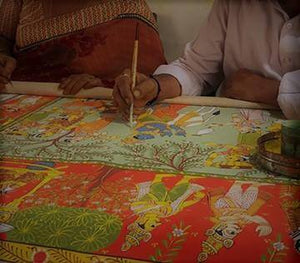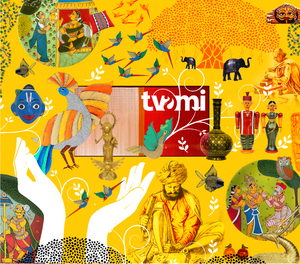
Gambhira Craft
"In the deep jungles of Bengal, tucked miles away from the reach of human civilization, a coven of witches, in giant painted masks dance in frenzy around a big fire; some have swords in their hands, others have axes. In a corner bound and gagged is a pretty young lady–the offering to Satan.” depicts a Bengali novel from the 18th century. This accurately explains how masks have always been a part of our culture from a very long time. With the exact origin still unknown, these mysterious masks have a very vague history.
Origin
According to many rumors, witches started the practice of wearing masks. In an attempt to camouflage, witches built a majestic facial veil made of paper or wood, which would help them attract the innocent and also prevent them from being exposed. Other stories explaining the origin of masks suggest that masks started during the time of the great migration in Bengal delta. With migrations, came the diverse cultures which were Aryans. It is this amalgamation of Aryans and non-Aryans which led to the introduction of masks, which is still reflected in the Bengal’s long-running tradition in mask artistry. Though the history of its advent is still vague, its influence is still very much seen in Bengal and across India. Being religiously important, masks have firmly impacted our history and traditions.
Technique
Gambhira masks have always been a popular prop used in Gambhira dance forms to propitiate the deity to usher in the peace and drive out the evil forces. The masks used are crafted using neem and fig tree wood and sometimes by clay by the local Sutradhar community. With the facial features being completed first, masks are then colored with natural or chemical colors to add a catchy definition to them. With the three-dimensional crown being its specialty, masks are a wonderful symbol of Bengal’s craftsmanship and its diverse cultural beauty.
What makes it special?
The Gambhira masks are of great religious importance owing to the belief in spells. They are also a deep-rooted symbol of negating geopolitical boundaries of the world. The mask has been a prop in various religious dance forms such as ‘Mukha Khel’ to appease the god. People would use mask as a revelation tool to make themselves formless, which would take them to the paths to the world of higher powers. Being used in various dance forms and religious functions doesn’t end their significance. They are used in regular life as well, such as wall hangings. The varied masks satisfy varied needs, which make them unique in their own sense.
The future
Gambhira art-form, like many other art-forms is on the wane. With no appreciation, the production of Gambhira craft pieces has declined with time. With the declining interest of the modern generation, Gambhira isn’t a cultural festival anymore; it is merely a performance now. The modern songs have entered the popular dance form, diminishing its original identity. The Gambhira artisans have felt its effect the most, which made them, leave this heritage craftwork and find alternative ways of income.



Leave a comment